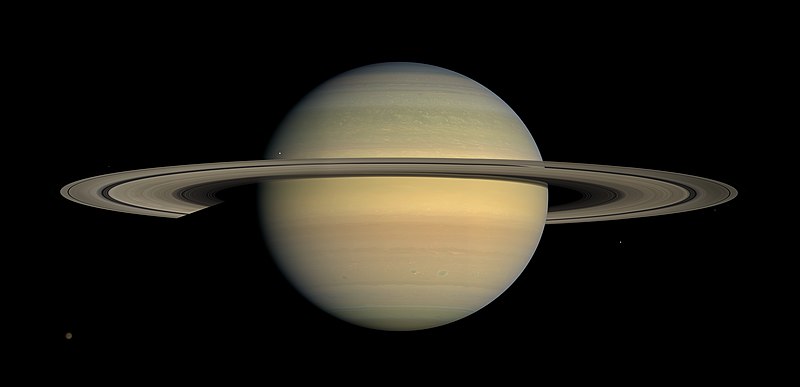Saturn now leads moon race with 62 newly discovered moons
May 11, 2023

May 11, 2023

An international team of astronomers, including University of British Columbia researchers, has announced the discovery of 62 new moons orbiting Saturn, catapulting the planet back into first place in the Solar System’s 'moon race'.
The new discoveries mean that Saturn has not only regained its crown for having the most known moons (overtaking Jupiter with 95 recognized moons), but it’s also the first planet to have over 100 discovered moons.
"Tracking these moons makes me recall playing the kid's game Dot-to-Dot, because we have to connect the various appearances of these moons in our data with a viable orbit,” says Dr. Edward Ashton, who started the research project at UBC, and currently a postdoctoral fellow at Taiwan's Academia Sinica Institute of Astronomy and Astrophysics. “But with about 100 different games on the same page and you don't know which dot belongs to which puzzle."
Over the past two decades, Saturn's surroundings have been repeatedly examined for moons with increasing sensitivity. In this latest study, Dr. Ashton's team used a technique known as 'shift and stack' in order to find fainter (and thus smaller) saturnian moons. The method has been used for moon searches around Neptune and Uranus, but never for Saturn.
Shifting a set of sequential images at the rate that the moon is moving across the sky results in enhancement of the moon's signal when all the data is combined, allowing moons that were too faint to be seen in individual images to become visible in the stacked image. The team used data taken using the Canada-France-Hawaii Telescope (CFHT) on top of Mauna Kea, Hawaii between 2019 and 2021. By shifting and stacking many sequential images taken during three hour spans, they were able to detect moons orbiting Saturn down to about 2.5 kilometres in diameter.
The team led by Ashton includes UBC professor Dr. Brett Gladman, Dr. Mike Alexandersen (Harvard Smithsonian Centre for Astrophysics), Dr. Jean-Marc Petit (Observatoire de Besancon), and Matthew Beaudoin (UBC).
The original discovery search was done in 2019 when Ashton and Beaudoin were students at UBC, uncovering the moons in a meticulous search of the deep CFHT imaging acquired that year. But just finding an object close to Saturn in the sky is insufficient to say for certain that it is a moon—it could an asteroid passing close to the planet (although this is unlikely).
To be absolutely sure, objects must be tracked for several years before they can be designated as certainly orbiting the planet. After painstakingly matching objects detected on different nights over two years, the team managed to track 63 objects, confirming them as new moons.
Some of the team's linked orbits were identified with past observations from many years ago that briefly glimpsed some of these moons (but were not tracked long enough to establish their orbit around Saturn).
All of the new moons are in the class of irregular moons, thought to be initially captured by their host planet long ago. Irregular moons are characterized by their large, elliptical, and inclined orbits compared to regular moons. The number of known saturnian irregular moons has more than doubled to 121, with 58 previously known before the search began. Including the 24 regular moons, there is now a total of 145 recognized by the International Astronomical Union.
The irregular moons tend to clump together into orbital groups based on the tilt of their orbits. In the saturnian system there are three such groups whose names are drawn from different mythologies: there is the Inuit group, the Gallic group, and the much more populated Norse group.
For example, eigth new discoveries fall in the Inuit group, with very small orbits tilted similarly to that of previously known larger irregulars Kiviuq and Ijiraq. All of the new moons fall into one of the three known groups, with the Norse group again being the most populated.
The groups are thought to be the result of collisions, where the current moons in a group are remnants of one or more collisions between the originally-captured moons. A better understanding of the orbital distribution thus provides insight into the collisional history of the irregular moon system of Saturn.
“As one pushes to the limit of modern telescopes, we are finding increasing evidence that a moderate-sized moon orbiting backwards around Saturn was blown apart something like 100 million years ago,” says Dr. Gladman.
Based on their past studies of these moons, this team has suggested that the large number of small moons on retrograde orbits is the result of a relatively recent (in astronomical terms, being in the last 100 million years) disruption of a moderately sized irregular moon now broken into the many fragments.
We honour xwməθkwəy̓ əm (Musqueam) on whose ancestral, unceded territory UBC Vancouver is situated. UBC Science is committed to building meaningful relationships with Indigenous peoples so we can advance Reconciliation and ensure traditional ways of knowing enrich our teaching and research.
Learn more: Musqueam First Nation